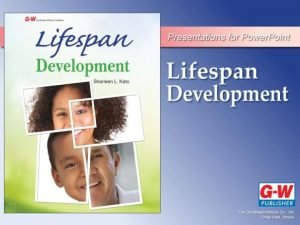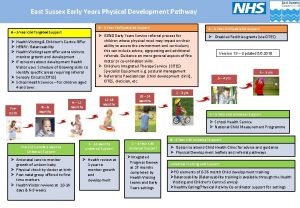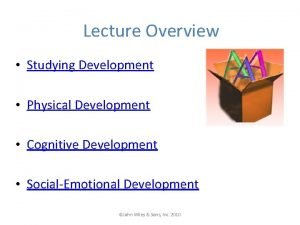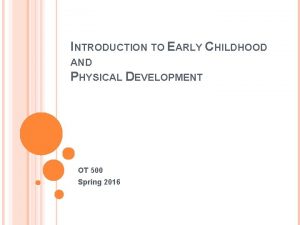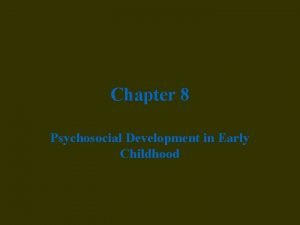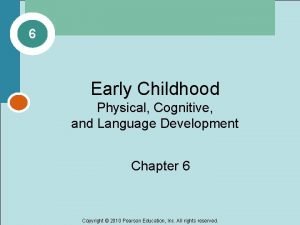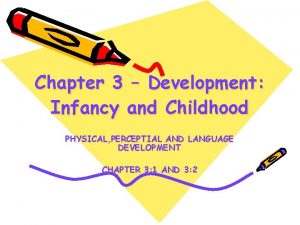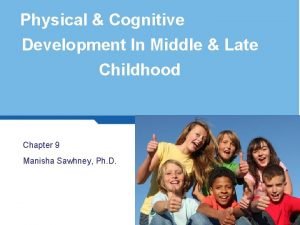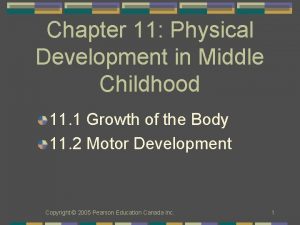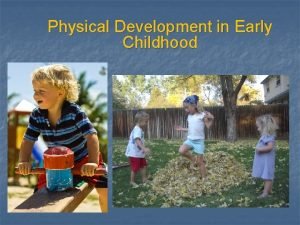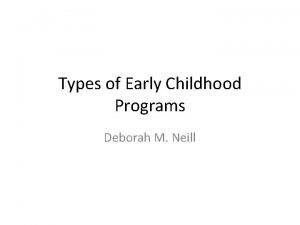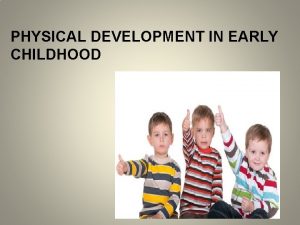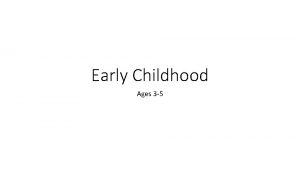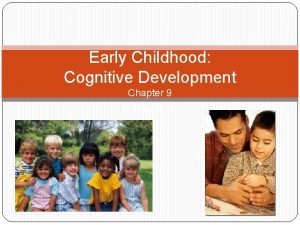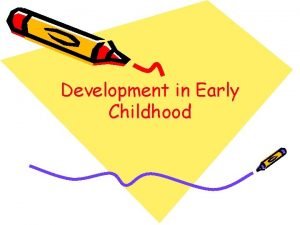Physical Development in Early Childhood Ages two to






























- Slides: 30

Physical Development in Early Childhood Ages two to five

Influences on Normal Physical Development • Genetic background • Disease • Nutritional needs during the preschool years

Genetic background • Height and to a lesser extent weight tend to follow the family pattern, dominant genes • Races and ethnic groups also differ slightly in average growth patterns

Disease • Some incidence of childhood disease is normal • It takes an extraordinary amount of disease to slow or arrest growth (as in maybe repeated otitis media) • “Catch-up growth” may follow illnesses

Typical ages recommended for immunizations • Birth to 2 months--hepatitis • 2 -6 months--Diptheria, pertussis, & tetanus; polio, haemophilus • 6 -18 months--Hepatitis booster, haemophilus booster • 15 -18 months--DPT booster, polio booster • 4 -6 years--DPT booster, polio booster • 10 -12 years--Measles, Mumps & Rubella

Nutritional needs of 2 -5 year olds • Natural to slow down on food intake compared to B-2 • Become selective and picky • Casual, repeated exposure to “new” foods is more effective than coercion

The Connection Between Health and Poverty • High poverty has been associated with high rates of stunted growth • School breakfast and school lunch programs are only part of the answer.

Brain development • Tomography, a process which enables observation of which parts of the brain are getting the highest rates of blood flow, is used to study the functioning of the brain

Tomographic findings about brain activity in preschoolers • Stimuli cause some activity over the entire range of the brain’s tissue • But some parts of the brain seem to be the leaders in certain operations • The visual cortex shows high blood flow and high glucose usage when the child is shown visually stimulating material • Visual cortex, in the back of the head, is where the headaches come from if vision problems exist

Wernicke’s area • Sounds of speech are apprehended in the auditory cortex in Wernicke’s area • In cases of damage to that area of the brain, auditory processing has been affected (learning disabilities)

The motor cortex • Located just forward of the top of the head • Enables motoric movement

Brocha’s area • Left side of the brain, forward of the ear and slightly above • Lateralization of language is strongest to this area • Injuries to this area are associated with aphasia or disphasia

Lateralization • Lateralization does not become settled until around the time of the onset of conservation, 6. 5 to 7 CA • Solidly-left or solidlyright handed persons show little difference from the norm

Lateralization (2) • But among mixedlateralized individuals, studies have found significantly higher numbers (43 -82%) of persons with learning and speech disabilities. • Primary school teachers should allow natural lateralizations

Sobering realization: We have made learning disabled and speech impaired students out of some folks by forcing laterality.

Brainstorming time on lateralization • Get in small groups of 4 or 5 • Discuss and report on the following: • How would you know a 7 year old’s natural handedness or lateralization? • How does a left-handed person write? • How can you help the left-handed writer? • What about cutting, drawing, coloring, and the left-handed writer?

Preschool Sensory Development • Visual acuity improves during the preschool years, and visual development is complete by around age 6. • Auditory acuity develops more rapidly and more completely than visual • But may children entering school do not have complete auditory Gestalts. They cannot pick out one sound attend to it.

Bladder control • Punctuated by many • About one-half of false starts and three year-olds still accidents wet their beds at least some of the time • Daytime control precedes nighttime • About one in five six control year-olds still bed-wet • Exact causes of bed • Fussing from parents wetting are not known, does not help but some pre-cautions seem obvious

End of third-year movement milestones • Climbs well • Walks up and down stairs, alternating feet • Kicks ball • Runs easily • Pedals tricycle • Bends over easily without falling

End-of-third year fine motor milestones • Note that this is the first time these have been mentioned. • Makes vertical, horizontal, and circular strokes with pencil or crayon • Turns book pages one at a time • Holds pencil in writing position • Screws/unscrews jar lids, nuts, and bolts • Turns rotating handles

End-of-third year language milestones • Follows a two or thee component command • Identifies almost all common objects and pictures • Understands most sentences • Uses four or five word sentences • Understands prepositional operands such as under, on, in • Can say name, age, and gender • Uses pronouns • Strangers can understand most of his words

The trend in milestones • Milestones and “developmental firsts” tend to be tightly clustered in the lower end of the developmental spectrum. • As we get older, the amount of time between new stages and events becomes gradually longer. • Early childhood and primary grade teachers tend to be very developmental in outlook whereas high school and college teachers pay less attention to development.

Ages 5 - 14 Boys Ages 5 - 14 Girls Ages 15 - 24 Boys Ages 15 - 24 Girls 150 Frequency per 100, 000 children 135 120 60 45 30 15 0 All causes Drownings, Motor fires, vehicle accidents poisons Accidents Other Infections Cancer accidents (all kinds) Heart Homicides diseases Diseases (selected) Cause of Death Suicides Violence

End-of-fourth year gross motor milestones • Hops and stands on one foot • Uses stairs without support • Kicks ball forward • Throws ball overhand • Catches bounced ball most of time • Moves forward and backward easily

End-of-fourth year fine motor milestones • • Copies square shapes Draws a person with two to four body parts Uses scissors Draws circles and squares (Beery and VMI tap these abilities extensively) • Begins to copy some capital letters

End of fourth year language milestones • Understands concepts of “same” and “different” • Speaks in sentences of 5 or 6 words • Speaks clearly enough for strangers to understand • Tells stories

End-of-fourth-year cognitive milestones • Names some colors • Understands concept of counting and knows a few numbers • Approaches problems from a single point of view • Beginning to have a clearer view of time • Follows three part commands • Recalls part of a story • Understands concepts of “same” and “different” • Engages in fantasy play

End-of-fourth year developmental danger signals • Cannot throw a ball overhand • Cannot jump in place • Cannot grasp a crayon between thumb and fingers • Has difficulty scribbling • Ignores other children • No interest in interactive games • No fantasy play • Resists dressing. Sleeping, suing the toilet • Lashes out--no self control of anger • Cannot copy a circle • Doesn’t use “me” or “you” appropriately

Sex and Gender difference in early childhood • Differences at this point in growth (2 -5) are slight between genders • They will start becoming more pronounced in the next stage of life.

Leaving early childhood • There is less need, usually, for constant and direct surveillance of five year olds than two year olds. • Children of this age begin to make their own agendas for activities rather than simply following their parents’ agendas.
 Chapter 7 early childhood ages 3 through 5
Chapter 7 early childhood ages 3 through 5 Physical development in early childhood
Physical development in early childhood 3 stages of prenatal development
3 stages of prenatal development Early childhood
Early childhood Fine motor skills development in early childhood
Fine motor skills development in early childhood Psychosocial development in early childhood
Psychosocial development in early childhood Language development in early childhood
Language development in early childhood Early childhood is __________ for language learning
Early childhood is __________ for language learning Biosocial development in early childhood
Biosocial development in early childhood Early childhood development with differentiated instruction
Early childhood development with differentiated instruction Dark ages def
Dark ages def Dark ages vs middle ages
Dark ages vs middle ages Physical development in middle childhood
Physical development in middle childhood Internally programmed growth of a child
Internally programmed growth of a child Late childhood physical development
Late childhood physical development Physical development in middle childhood chapter 11
Physical development in middle childhood chapter 11 Physical development in middle childhood
Physical development in middle childhood Cognitive development in middle and late childhood
Cognitive development in middle and late childhood Rovee-collier
Rovee-collier Early middle ages
Early middle ages Early middle ages
Early middle ages The stone ages and early cultures
The stone ages and early cultures Early adulthood cognitive development
Early adulthood cognitive development Early adulthood development stages
Early adulthood development stages Cognitive development during early adulthood
Cognitive development during early adulthood Types of early childhood programs
Types of early childhood programs Types of early childhood programs chapter 2
Types of early childhood programs chapter 2 Efq
Efq Early childhood framework for quality
Early childhood framework for quality Rockefeller professional development
Rockefeller professional development Welcome dear parents
Welcome dear parents
